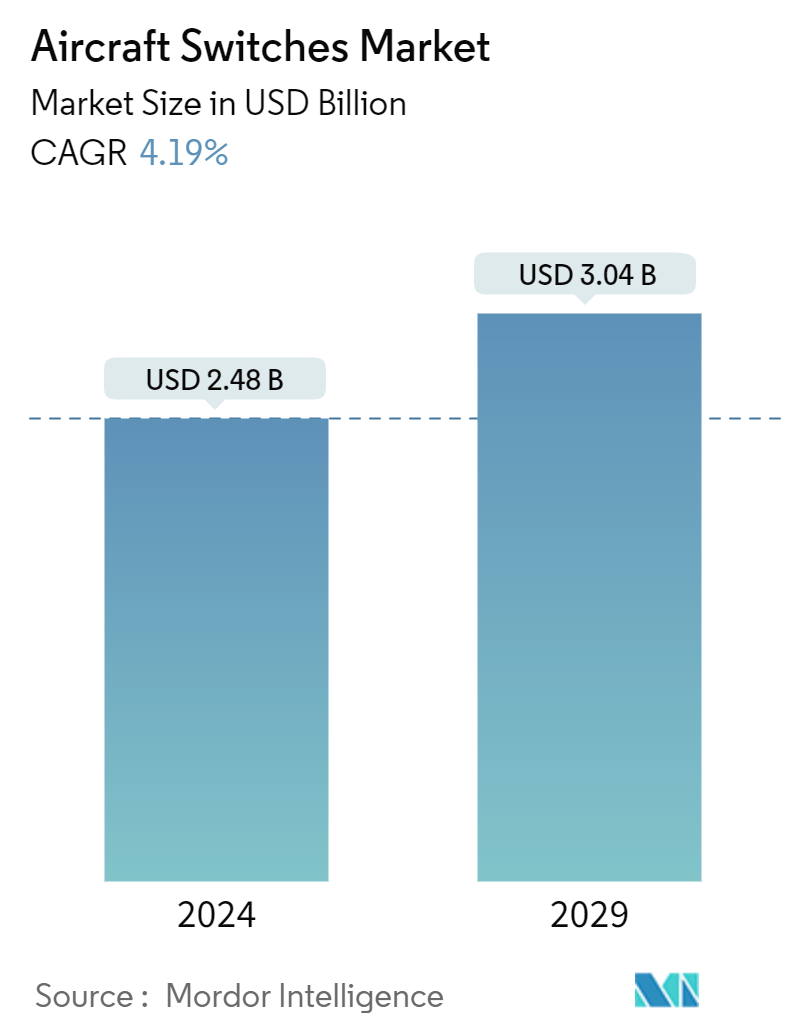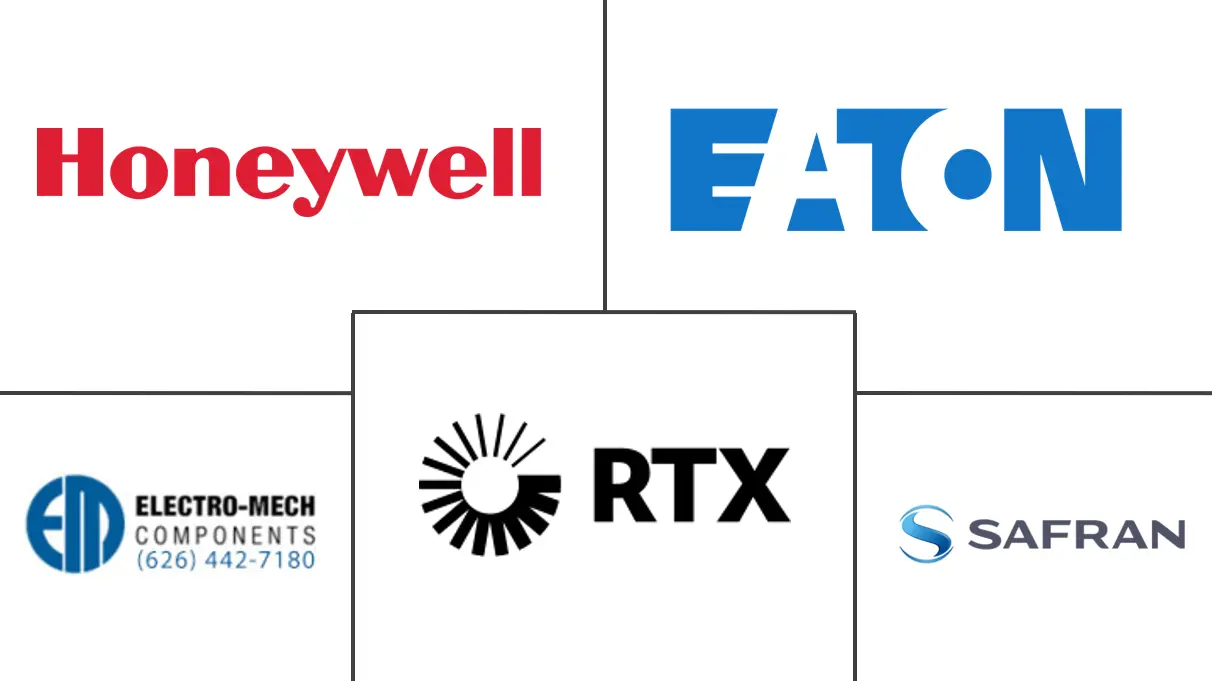Market Size of Aircraft Switches Industry

| Study Period | 2019 - 2029 |
| Market Size (2024) | USD 2.48 Billion |
| Market Size (2029) | USD 3.04 Billion |
| CAGR (2024 - 2029) | 4.19 % |
| Fastest Growing Market | Asia Pacific |
| Largest Market | North America |
Major Players
*Disclaimer: Major Players sorted in no particular order |
Aircraft Switches Market Analysis
The Aircraft Switches Market size is estimated at USD 2.48 billion in 2024, and is expected to reach USD 3.04 billion by 2029, growing at a CAGR of 4.19% during the forecast period (2024-2029).
The commercial aircraft sector's ramped-up production and deliveries fuel a global surge in demand for aircraft switches. This demand is further bolstered by the rising popularity of advanced IFEC systems and the shift toward more interactive IFEC setups. Specifically, the IFEC sector is witnessing a surge as traditional backseat screens, offering limited entertainment, are being replaced by personalized models.
Modern military and commercial aircraft are embracing human-machine interface (HMI) designs, enhancing automation and easing pilot workloads. This, coupled with the broader trend of aircraft digitization, drives the need for updated switching technologies. Cockpits increasingly favor pushbutton switches with light-emitting diodes, especially as they integrate digital data bus interfaces.
As the aviation industry leans towards lighter aircraft, there is a growing fascination with fly-by-wire systems. These systems, managed by processors, streamline autopilot controls by transmitting electrical signals through electronic switches. The rising demand for fly-by-wire installations in new aircraft is set to propel the growth of the aircraft switching market.
However, advanced switches come with high price tags, and stringent regulations could lead to approval delays and increased development costs. Additionally, fluctuating raw material prices impact manufacturing costs and squeeze profit margins for industry players.
Aircraft Switches Industry Segmentation
Aircraft switches play a crucial role in overseeing and managing various aircraft systems. The cockpit dashboard hosts a myriad of switches, ranging from push buttons and toggles to rocker switches. With the rising wave of digitization, the aviation industry has witnessed a surge in the demand for in-flight entertainment and connectivity (IFEC). This demand, coupled with advancements in technology, has notably enhanced the capabilities of aircraft switch technology.
The aircraft switches market is segmented by application and geography. By application, the market is segmented into commercial, military, and general aviation. The report also covers the market sizes and forecasts for the aircraft switches market in major countries across different regions. For each segment, the market size is provided in terms of value (USD).
| Application | |
| Commercial | |
| Military | |
| General Aviation |
| Geography | |||||||
| |||||||
| |||||||
| |||||||
| |||||||
|
Aircraft Switches Market Size Summary
The aircraft switches market is poised for steady growth, driven by the increasing production and delivery of aircraft, particularly in the commercial sector. This demand is further fueled by the rising need for advanced in-flight entertainment and connectivity systems, which are replacing traditional, less interactive options. The market is also experiencing a shift towards more automated and digitized cockpit designs, necessitating the replacement of conventional switching technologies with modern alternatives like LED pushbutton switches. The trend towards lighter aircraft and the adoption of fly-by-wire systems, which rely on electronic switches for flight control, are additional factors contributing to market expansion. The commercial segment is expected to dominate, supported by the high rate of aircraft production and the growing sophistication of cabin systems, which require a greater number of switches compared to military and general aviation aircraft.
Regionally, the Asia-Pacific market is anticipated to witness significant growth, driven by increasing passenger traffic and the subsequent demand for new aircraft in emerging economies such as China and India. This region is projected to become the largest aviation market, with substantial contributions from countries like Japan and Indonesia. The military sector in the region is also expected to boost demand for aircraft switches due to increased territorial conflicts and the strengthening of military aircraft fleets. The market is characterized by fragmentation, with numerous local and global players tailoring their offerings to meet the specific needs of aircraft manufacturers. Key industry players include Safran SA, Honeywell International Inc., RTX Corporation, Eaton Corporation plc, and Electro-Mech Components Inc., all of which are actively expanding their product lines and strategic partnerships to capture a larger market share.
Aircraft Switches Market Size - Table of Contents
-
1. MARKET DYNAMICS
-
1.1 Market Overview
-
1.2 Market Drivers
-
1.3 Market Restraints
-
1.4 Industry Attractiveness - Porter's Five Forces Analysis
-
1.4.1 Bargaining Power of Suppliers
-
1.4.2 Bargaining Power of Buyers/Consumers
-
1.4.3 Threat of New Entrants
-
1.4.4 Threat of Substitute Products
-
1.4.5 Intensity of Competitive Rivalry
-
-
-
2. MARKET SEGMENTATION
-
2.1 Application
-
2.1.1 Commercial
-
2.1.2 Military
-
2.1.3 General Aviation
-
-
2.2 Geography
-
2.2.1 North America
-
2.2.1.1 United States
-
2.2.1.2 Canada
-
-
2.2.2 Europe
-
2.2.2.1 United Kingdom
-
2.2.2.2 Germany
-
2.2.2.3 France
-
2.2.2.4 Russia
-
2.2.2.5 Rest of Europe
-
-
2.2.3 Asia-Pacific
-
2.2.3.1 China
-
2.2.3.2 Japan
-
2.2.3.3 India
-
2.2.3.4 South Korea
-
2.2.3.5 Rest of Asia-Pacific
-
-
2.2.4 Latin America
-
2.2.4.1 Brazil
-
2.2.4.2 Rest of Latin America
-
-
2.2.5 Middle East and Africa
-
2.2.5.1 United Arab Emirates
-
2.2.5.2 Saudi Arabia
-
2.2.5.3 Egypt
-
2.2.5.4 South Africa
-
2.2.5.5 Rest of Middle East and Africa
-
-
-
Aircraft Switches Market Size FAQs
How big is the Aircraft Switches Market?
The Aircraft Switches Market size is expected to reach USD 2.48 billion in 2024 and grow at a CAGR of 4.19% to reach USD 3.04 billion by 2029.
What is the current Aircraft Switches Market size?
In 2024, the Aircraft Switches Market size is expected to reach USD 2.48 billion.

